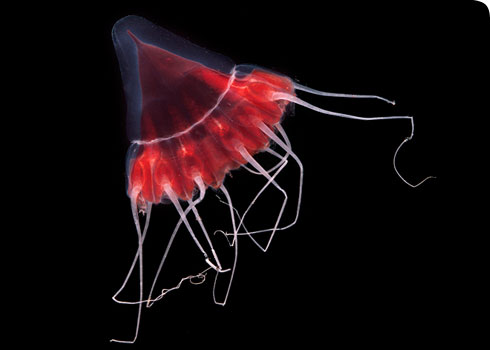Periphylla periphylla (crown or helmet jellyfish)
Periphylla periphylla is found in every ocean of the world apart from the Arctic, at 1,000 to 7,000 metres deep.
Light is toxic to this jellyfish and it only moves up to shallower depths at night.
Like many jellyfish Periphylla periphylla has large stinging cells on its tentacles that it uses to attack prey.
It is unusual because it can produce flashes of light by a chemical reaction called bioluminescence that helps protect it from predators.
Species detail
-

Distribution
This jellyfish can be found in almost every ocean in the world. It is also found in other deep waters. Find out where.
-
Biology
Periphylla periphylla has an unusual life cycle and can live for 30 years. Find out more.
-

Behaviour
Periphylla periphylla can detect light, which it avoids. It also produces light of its own to fend off predators. Find out what else this clever jellyfish does to survive.
-

References
Get more reference information about Periphylla periphylla.
Distribution map
A world map showing the distribution of Periphylla periphylla
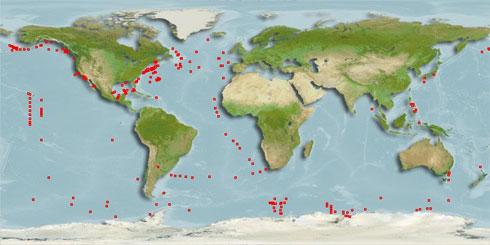
Distribution records for Periphylla periphylla held by the Ocean Biogeographic Information System (OBIS) (accessed 13th May 2010) www.iobis.org © Rutgers, The State University of New Jersey, 2002-2007. OBIS v3.1
Images
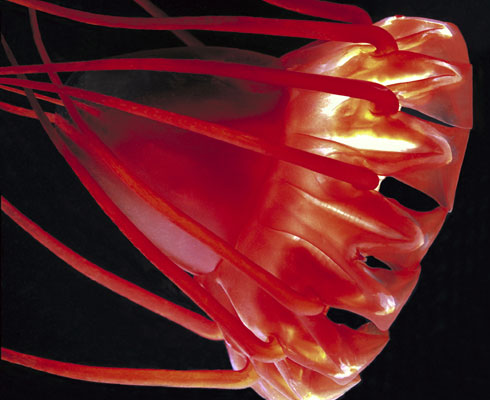
Periphylla periphylla from surface waters, western Norway in 1998. Here the swimming bell is opaque.
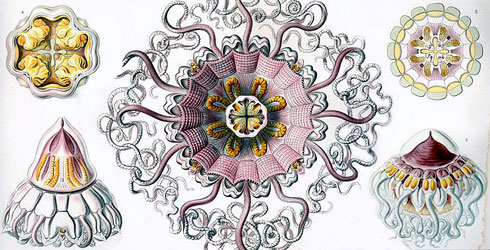
Illustrations of Periphylla from Kunstformen der Natur (Artforms of Nature) (1904) by the German biologist Ernst Haeckel, who was the author of the genus Periphylla, Haeckel 1880.
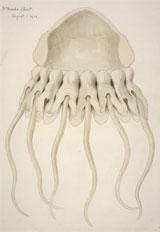
Drawing of Periphylla periphylla, produced in 1902 by Edward Adrian Wilson (1872-1912), Zoologist and Junior Surgeon on the 1901-1904 Discovery Expedition to the Antarctic, under Commander Robert Falcon Scott (1868-1912).

Distribution records for Periphylla periphylla held by the Ocean Biogeographic Information System (OBIS) (accessed 13th May 2010) www.iobis.org
© Rutgers, The State University of New Jersey, 2002-2007. OBIS v3.1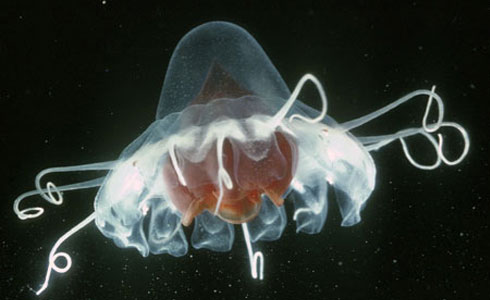
Juvenile Periphylla periphylla - the red-coloured stomach is visible beneath the transparent bell.
About the author

Mr Andrew Cabrinovic
Curator of Lower Invertebrates, responsible principally for the Echinodermata and Cnidaria collections.
Author's quote
"I chose Periphylla periphylla because despite being an abundant animal in the world’s oceans, it usually lives very deep down, so very few people have seen it or know about it.
These jellyfish are an active species, they do not just float around passively waiting for prey to blunder into them!
It is also interesting that they occur in large numbers in Norwegian fjords, and seem to have taken the place of fish in the ecosystem - in the case of Lurefjorden at least."
